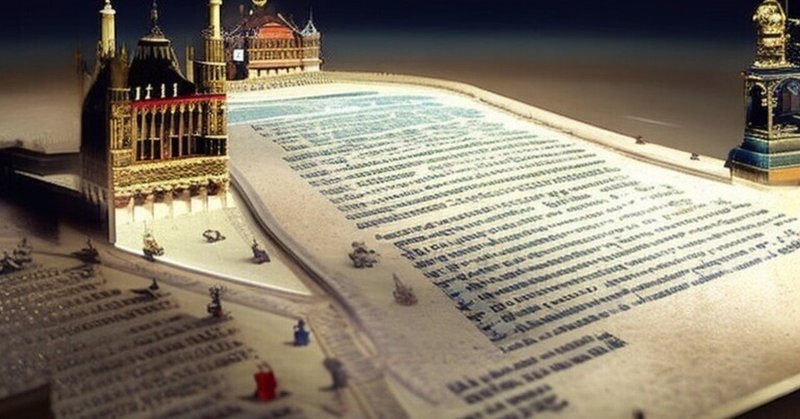
英語長文問題クエスト Part 99 (テーマ:マグナ・カルタ)
英語の読解力を伸ばすには多読が必須!特に、TOEFL ibt というテストでは、かなり高度な読解力が必要ですし、何より、このTOEFL ibt という試験が難しいことの理由の1つに、日本語でも勉強していないアカデミックな内容の文章が出題されることです。
このクエストを進めれば、英語の読解力と知識を同時にアップデートさせられるでしょう!
さぁ、今日のクエストを進めてみましょう!
Passages
Title: Magna Carta: The Cornerstone of Constitutional Law
Introduction
The Magna Carta, a historic document sealed in 1215, is often regarded as the foundation of constitutional law and individual liberties in English-speaking countries. Its Latin name translates to "Great Charter," and indeed, its impact has been monumental. This document was not just a peace treaty between King John of England and his barons but a significant step in the evolution of limited government and the rights of citizens.
Historical Context
In the early 13th century, King John's tyrannical rule led to widespread discontent among the nobility. Faced with rebellion, he met with his barons at Runnymede and agreed to a document that would restrict his powers and protect the barons' rights. While the document had its limitations and was initially annulled by the Pope, it laid the groundwork for future challenges to royal authority and became a symbol of the rule of law.
Key Provisions
The Magna Carta addressed various issues of the time, including taxation, the protection of widows and heirs, and limitations on feudal payments. One of its most crucial provisions was that no free man could be imprisoned or stripped of his rights except through a lawful judgment by his peers or by the law of the land. This concept, known as due process, became a fundamental principle in legal systems worldwide.
Legacy and Global Influence
While the Magna Carta was a medieval document, its principles have transcended time and borders. It influenced constitutional developments not only in England but also in other countries. In the United States, the framers of the Constitution drew inspiration from its principles when shaping the Bill of Rights. Additionally, many Commonwealth nations incorporated Magna Carta's ideals into their legal frameworks, emphasizing the importance of individual freedoms and limitations on governmental power.
Challenges and Interpretations
Interpreting the Magna Carta's exact meaning and relevance in modern contexts has been a subject of debate among scholars and legal experts. While some view it as a cornerstone of democratic principles, others argue that its original intent was to safeguard the interests of the nobility rather than those of ordinary citizens. However, there is no denying its symbolic significance as a symbol of justice, fairness, and the rule of law.
Conclusion
The Magna Carta's enduring legacy lies not only in its historical significance but also in the principles it embodies. It symbolizes the idea that no one, not even a king, is above the law and that individuals have inherent rights that must be protected. As societies continue to grapple with questions of governance and individual liberties, the Magna Carta remains a guiding light, reminding us of the importance of upholding justice and fundamental rights in the face of power and authority.
Questions
What does the Latin term "Magna Carta" mean?
A) Great War
B) Great Charter
C) Royal Decree
D) King's LegacyWhat led to the creation of the Magna Carta?
A) The King's popularity
B) Discontent among the nobility
C) A successful military campaign
D) Religious conflictsWhat is the significance of the due process principle in the Magna Carta?
A) It protects individuals from arbitrary imprisonment and loss of rights.
B) It grants the king absolute power over legal matters.
C) It ensures swift judgment without a trial.
D) It restricts the rights of free men.In which country did the Magna Carta originate?
A) France
B) England
C) Spain
D) ItalyWhat did the Magna Carta primarily address?
A) Taxation and land ownership
B) Protection of individual rights and limitations on governmental power
C) Foreign policy matters
D) Religious doctrinesHow did the Magna Carta influence the United States?
A) It inspired the design of the British Parliament.
B) Its principles were incorporated into the Bill of Rights.
C) It led to the American Revolution.
D) It established the foundation for the American monarchy.What is a point of debate among scholars regarding the Magna Carta?
A) Its impact on art and literature
B) Its relevance to modern democracy and ordinary citizens
C) Its influence on international trade
D) Its connection to ancient religious practicesWhat does the Magna Carta symbolize regarding the law?
A) The supremacy of the king's decisions
B) The authority of the church over legal matters
C) The idea that nobody, not even a king, is above the law
D) The importance of noble birth in legal proceedingsWhich term best describes the Magna Carta's influence outside of England?
A) Regional
B) Limited
C) Global
D) Nonexistent
Answers and Explanations
ここから先は
¥ 200
この記事が気に入ったらサポートをしてみませんか?
